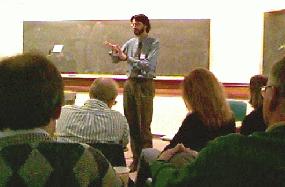

 |
 |
 1998 TEACHER EDUCATION WORKSHOP ON ALCOHOL ABUSE IN ADOLESCENCE
1998 TEACHER EDUCATION WORKSHOP ON ALCOHOL ABUSE IN ADOLESCENCE
Alcohol abuse in adolescence is the most persistent and pervasive problem negatively affecting the physical health, emotional well-being and educational performance of students, both inside and outside the classroom and recent studies have linked early drinking behavior to later alcoholism. It is important that teachers be fully aware of 1) the patterns and problems of youthful alcohol abuse, 2) the resources available to become more knowledgeable about the complexities of the problem, and 3) the varied opportunities to bring these issues into the classroom in a variety of course subjects and in informal discussions with students. In order to enhance teacher awareness in these areas, the Alcohol and Other Drug Education Project of Hobart and William Smith Colleges sponsored a workshop for local area professionals working in secondary education and for college students at Hobart and William Smith preparing for careers in education.
![]() Workshop Participants
Workshop Participants
HWS Student Teacher Participants:
Teacher/Administrator Participants:

Wesley Perkins, Ph.D., Professor of Sociology at Hobart and William
Smith Colleges.
Dr. Perkins is Director of the Alcohol and Other Drug Education Project and
is a nationally recognized researcher, speaker, and consultant on alcohol
abuse in youth and young adulthood with special expertise on topics of peer,
gender, family, and environmental influences on drinking.

David Craig, Ph.D., Professor of Chemistry at Hobart and William Smith
Colleges.
Dr. Craig is Co-Director of the Alcohol and Other Drug Education Project and
is a leader in national efforts to reform science education. He has special
expertise in teaching about the biochemistry of alcohol and its effects and
making the material accessible for students and teachers of diverse
backgrounds.
Participant Last Name
First Name
School Affiliation
Position/Subject Area
1
Billings
Anne
Geneva Middle School
2
Bindig
Matt
Waterloo High School
English
3
Culliton
Courtney
Canandaigua 3rd Grade
4
Cutter
Sarah
Mynderse Academy
Gr. 12
5
Farquhar
Heather
Gr. 3
6
Kelly
Sarah
Geneva High School
English
7
Krenzer
Dan
Marcus Whitman High School
Biology
8
Oberfield
Zachary
Waterloo High School
12th grade
9
Savino
Michelle
North St. Elementary
Special/elem. Ed.
10
Schoff
Wendi
Mynderse Academy
secondary math
11
Schuenemann
Anna
HWS student
12
Sprott
Amy
West St. Elementary
Special/elem. Ed.
13
Thibodeau
Susan
North St. Elementary
Reg,& Spec. Ed.
Participant Last Name
First Name
School Affiliation
Position/Subject Area
1
Arruda
Bill
Geneva Middle School
6th grade social studies / health
2
Blazak
Paige
Geneva Middle School
school counselor
3
Brooks
Traci
Geneva Middle School
6th grade math
4
Butler
Molly
Geneva Middle School
home and career skills
5
Corcoran
John
Geneva High School
school counselor
6
Gerhardt
Stacey
Geneva Middle School
social studies
7
Grenier
Randy
Geneva High School
health
8
Johnson
Kathy
Waterloo High School
English
9
Kerr
Pat
Hobart & Wm Smith Colleges
Professor of Education
10
Major
David
Seneca Falls Middle School
7th grade math
11
Marino
Susan
Mynderse Academy
math
12
McSweeney
Tim
Geneva High School
school counselor
13
Meyer
Anne Marie
Geneva High School
health & family / consumer sci.
14
Natti
John
Geneva School System
15
Nyrop
Jerri
Geneva Middle School
home and career skills
16
Simizon
Marlene
Geneva Middle School
Alternative Ed.
17
Sutton
Cindy
Hobart & Wm Smith Colleges
Professor of Education
18
Tepper
Douglas
Geneva High School
English
19
Urban
Joseph
Geneva High School
Sociology / Anthropology / Government / Psychology
20
Wiltse
Trish
Geneva Middle School
school counselor
21
Wright
Ed
Geneva School System
Director of Curriculum & Instruction
![]() Workshop Schedule
Workshop Schedule
|
9:00-9:15am |
Purpose and Introductions |
|
9:15-10:00am |
Overview of national trends and patterns of adolescent use. See this NIAAA review on youth drinking. |
|
10:-10:30am |
Science of alcohol and its effects on human behavior: Part I -- Blood Alcohol Concentration(BAC); Absorbtion and Metabolism of alcohol; Gender and Ethnic differences. See this NIAAA review on alcohol metabolism and absorption. Slides. |
|
10:30-10:45am |
Break |
|
10:45-11:15am |
Science of alcohol and its effects on human behavior: Part II -- Pharmacology of Alcohol and its effect on the brain; pharmacological basis for tolerance, dependence, and withdrawal; recognition of these problem indicators among adolescents; Fetal Alcohol Syndrome -- physical and cognitive manifestations and implications for teenage pregnancy. See this NIAA review of Fetal Alcohol Syndrome. Slides. |
|
11:15-12:15pm |
Social and psychological causes of abuse in school populations |
|
12:15-1:30pm |
Lunch/Discussion of common interests in Scandling Common Room; identification of key issues for elementary, middle and high school education levels; identification of potential program development strategies. See this NIAAA review and assessment of alcohol prevention programs and policies. |
|
1:45-2:45pm |
Resources: Print and video materials available locally ( journals and books and videos ) and World Wide Web links to resources for students and teachers |
|
2:45- 3:00pm |
Concluding Comments and Evaluation |
This workshop is provided through the generous support of the Christopher
D. Smithers Foundation,
page last modified: 11/29/1999
Address comments and suggestions to Prof. David Craig ( craig@hws.edu ) or Prof. H. Wesley Perkins ( perkins@hws.edu )